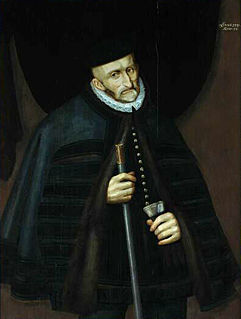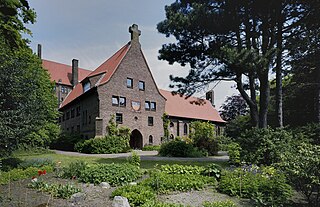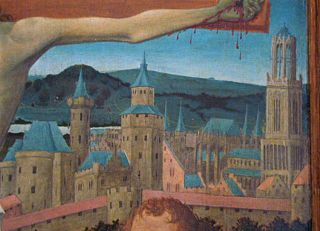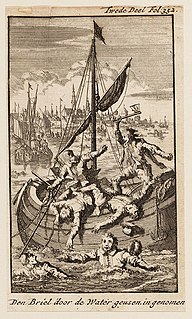Diederik Sonoy | |
|---|---|
 | |
| Born | 1529 Kalkar |
| Died | 2 June 1597 Pieterburen |
| Occupation | |
Diederik Sonoy or Snoey (Kalkar (Duchy of Cleves), 1529 - Pieterburen, 2 June 1597) was a leader of the Geuzen during the Eighty Years' War.
Diederik Sonoy | |
|---|---|
 | |
| Born | 1529 Kalkar |
| Died | 2 June 1597 Pieterburen |
| Occupation | |
Diederik Sonoy or Snoey (Kalkar (Duchy of Cleves), 1529 - Pieterburen, 2 June 1597) was a leader of the Geuzen during the Eighty Years' War.
Diderick Sonoy was born about 1529 in the Duchy of Cleves, but afterwards resided mostly in Holland and especially at the Hague, where he evinced great zeal for the reformation. He early entered military life, signed the compromise of Nobles, and was one of the most fierce advocates of the interests of the Prince of Orange. He gained the first naval victory over the Spanish fleet in July 1568. On 2 June 1572 he arrived at Enkhuizen. He was provided by William the Silent with a commission, appointing him Lieutenant-Governor of North Holland or Waterland. Troops under his command put both Egmond Castle and Egmond Abbey on fire in 1573. The destruction of these strategic locations prevented that the Spanish army could occupy them.
When he was discharged and received a pension he and his family crossed over to England, where he endeavoured to drain some land granted him by Elizabeth I; but failing he returned (1593) to East Frisia, resided for some time at Norden, and died 2 June 1597 on his seat near Pieterburen.
Sonoy was a narrow-minded religious fanatic and a furious persecutor of Catholics. After the Geuzen captured Alkmaar, they took prisoners five friars from the Franciscan monastery outside the city. Sonoy ordered them to be brought to Enkhuizen and had them hanged (martyrs of Alkmaar). [1] Engelbert Terburg, a lay brother of the same monastery, was transferred by Sonoy to the village of Ransdorp, near Amsterdam, where he was hanged on 11 August 1572 after being subjected to torture. [1]

Guelders or Gueldres is a historical county, later duchy of the Holy Roman Empire, located in the Low Countries.

Alkmaar is a city and municipality in the Netherlands, located in the province of North Holland. Alkmaar is well known for its traditional cheese market. For tourists, it is a popular cultural destination. The municipality has a population of 109,896 as of 2021.

Enkhuizen is a municipality and a city in the Netherlands, in the province of North Holland and the region of West-Frisia.

Egmond aan den Hoef is a village in the Dutch province of North Holland. It is a part of the municipality of Bergen, and lies about 7 kilometres (4.3 mi) west of Alkmaar. Until 2001, Egmond aan den Hoef was part of the municipality of Egmond.
Charles II was a member of the House of Egmond who ruled as Duke of Guelders and Count of Zutphen from 1492 until his death. He was the son of Adolf of Egmond and Catharine of Bourbon. He had a principal role in the Frisian peasant rebellion and the Guelders Wars.

The siege of Haarlem was an episode of the Eighty Years' War. From 11 December 1572 to 13 July 1573 an army of Philip II of Spain laid bloody siege to the city of Haarlem in the Netherlands, whose loyalties had begun wavering during the previous summer. After the naval battle of Haarlemmermeer and the defeat of a land relief force, the starving city surrendered and the garrison was massacred. The resistance nonetheless was taken as an heroic example by the Orangists at the sieges of Alkmaar and Leiden.

William of Jülich-Cleves-Berge was a Duke of Jülich-Cleves-Berg (1539–1592). William was born in and died in Düsseldorf. He was the only son of John III, Duke of Jülich-Cleves-Berg, and Maria, Duchess of Jülich-Berg. William took over rule of his father's estates upon his death in 1539. Despite his mother having lived until 1543, William also became the Duke of Berg and Jülich and the Count of Ravensberg.

Geuzen medals, Beggars' or Sea Beggars' medals were minted early in the Dutch Revolt and during the first half of the 16th-century Eighty Years' War. During that period, many medals, tokens and jetons with a political message were minted. The earliest Geuzen medals date from the mid-16th century to 1577.

The Battle of Dahlen was fought on April 23, 1568, between a Dutch rebel army led by Jean de Montigny, Lord of Villers, and a Spanish army commanded by Sancho Dávila y Daza. As a part of William of Orange's planned invasion, the Dutch rebels were trying to conquer the town of Roermond when the arrival of the Spanish force compelled them to withdraw. Dávila pursued the retreating force and inflicted a defeat upon Villers near the small town of Dahlen. The survivors of this encounter sought refuge under the walls of Dahlen, where the Spanish infantry finally defeated them. This battle is sometimes considered the official start of the Eighty Years' War.

Egmond Abbey or St. Adalbert's Abbey is a Benedictine monastery of the Congregation of the Annunciation between Egmond aan den Hoef and Bakkum in Egmond-Binnen in the municipality of Bergen in the Dutch province of North Holland. Founded in 920-925 and destroyed in the Reformation, it was re-founded in 1935 as the present Sint-Adelbertabdij, in the Diocese of Haarlem.

John III of Egmont was first Count of Egmont, Lord of Baer, Lathum, Hoogwoude, Aarstwoude, Purmerend, Purmerland and Ilpendam, and Stadtholder of Holland, Zeeland and West-Friesland.

Upper Guelders or Spanish Guelders was one of the four quarters in the Imperial Duchy of Guelders. In the Dutch Revolt, it was the only quarter that did not secede from the Habsburg monarchy to become part of the Seven United Netherlands, but remained under Spanish rule during the Eighty Years' War.

Reginald IV was the second duke to rule both Guelders and Jülich

The Utrecht war of 1481–83 was a diocesan feud in the Prince-Bishopric of Utrecht between 1481 and 1483, influenced by the ongoing Hook and Cod wars in the neighbouring County of Holland. It was also a battle for control over Utrecht between the Dukes of Burgundy in the person of ruling Bishop David of Burgundy, and the Duchy of Cleves, which sought to replace him with Engelbert of Cleves.

The siege of Sluis of 1587 took place between 12 June and 4 August 1587, as part of the Eighty Years' War and the Anglo-Spanish War (1585–1604). Its capture by the Spanish formed a significant advance towards the Enterprise of England.

Radboud Castle is a castle on the east bank of the harbour in Medemblik.

Willem Bloys van Treslong was a nobleman from the Southern Netherlands and military leader during the Dutch war of Independence. He was best known as one of the leaders of the Sea Beggars who captured Den Briel on 1 April 1572.

Marie de Brimeu, was a Flemish noblewoman known for her knowledge of botany and horticulture. She inherited her titles from her uncle, Charles de Brimeu, Count of Meghem, when he died in 1572, becoming the Countess of Meghem. Her second marriage in 1580 to Charles III, Prince of Chimay, elevated her to the rank of Princess.

The period between the Capture of Brielle and the Pacification of Ghent was an early stage of the Eighty Years' War between the Spanish Empire and groups of rebels in the Habsburg Netherlands.

The Martyrs of Alkmaar were a group of 5 Dutch Catholic clerics, secular and religious, who were hanged on 24 June 1572 in the town of Alkmaar by militant Dutch Calvinists during the 16th-century religious wars—specifically, the Dutch Revolt against Spanish rule, which developed into the Eighty Years' War. These atrocities were inflicted by the Calvinist leader, Diederik Sonoy.